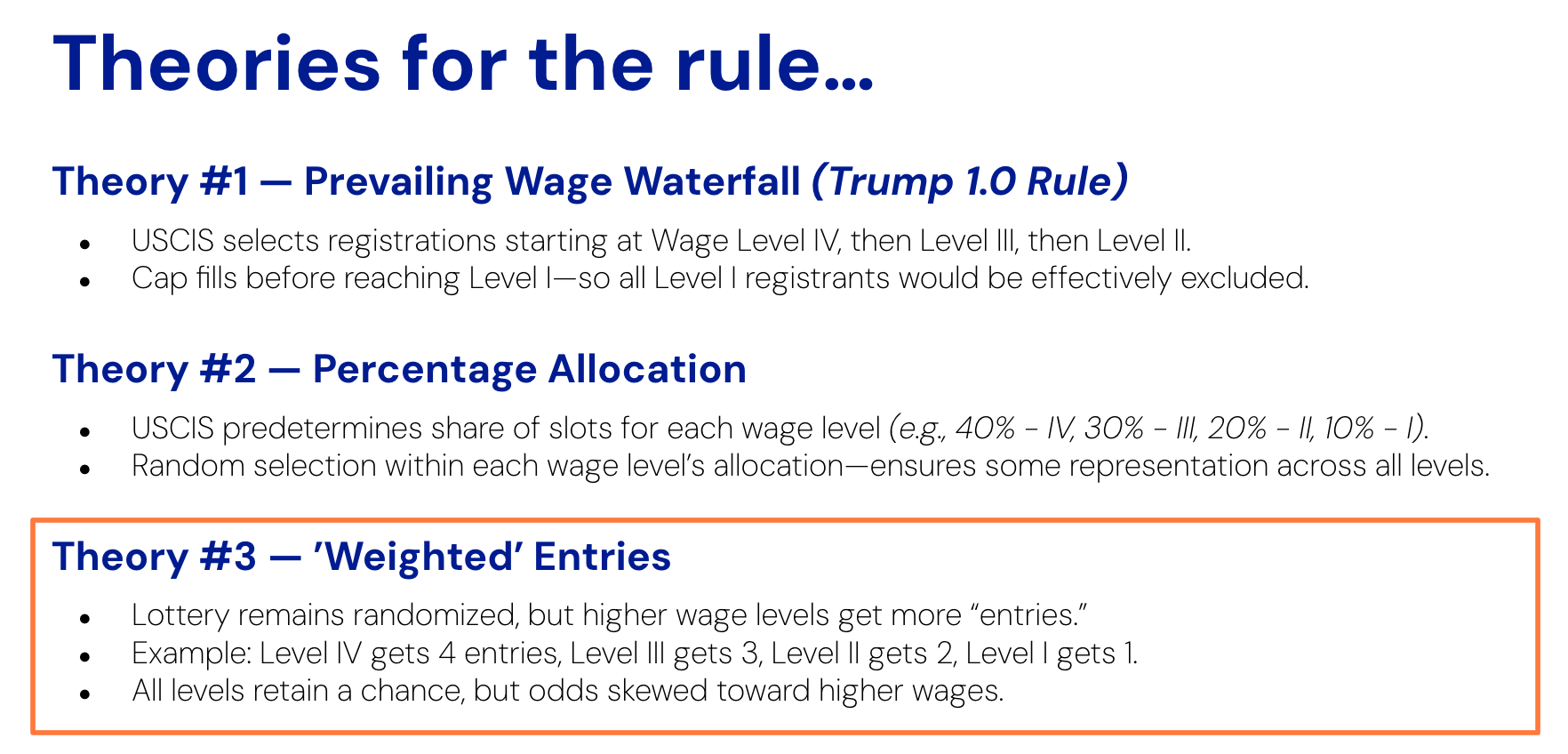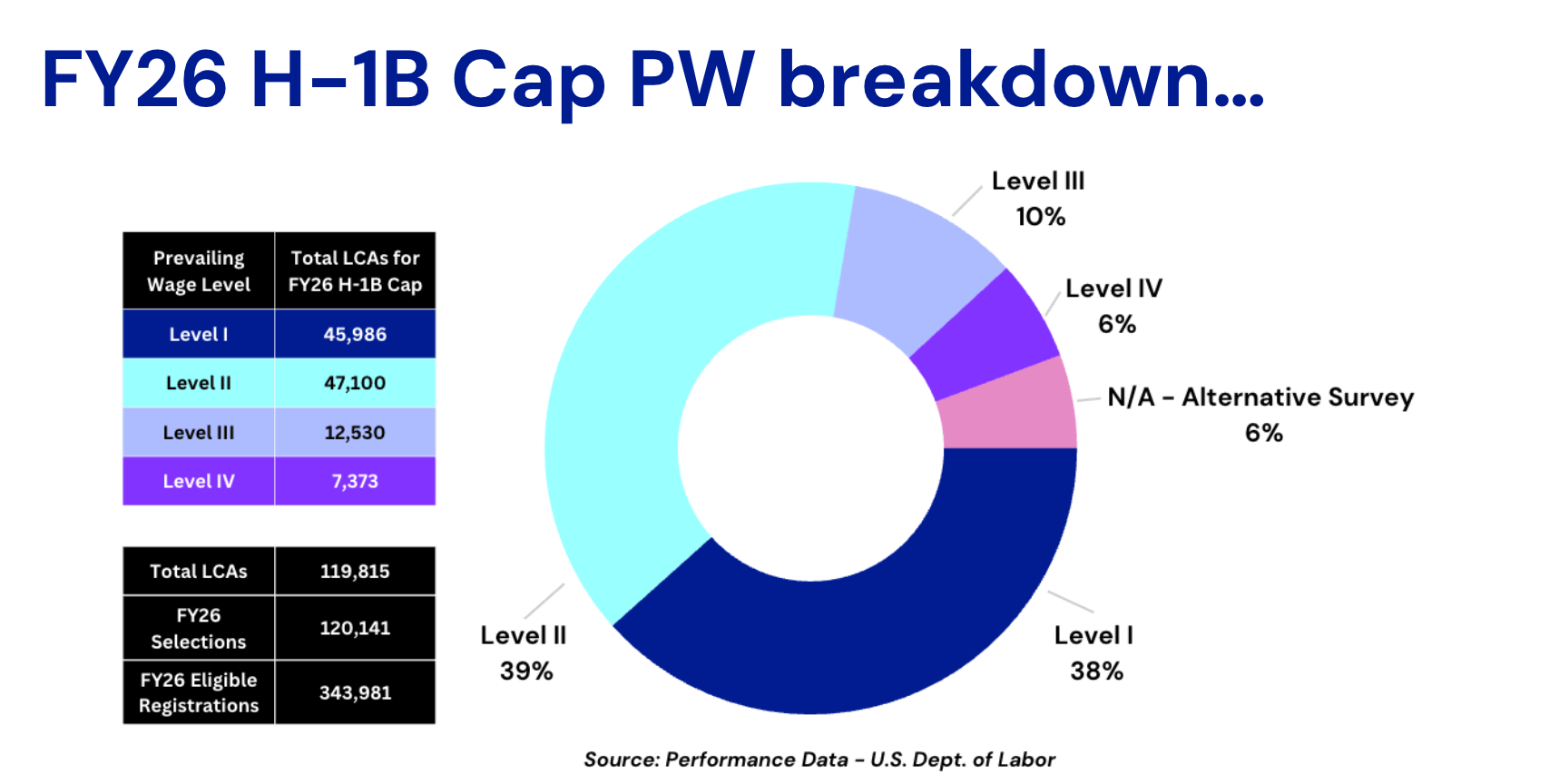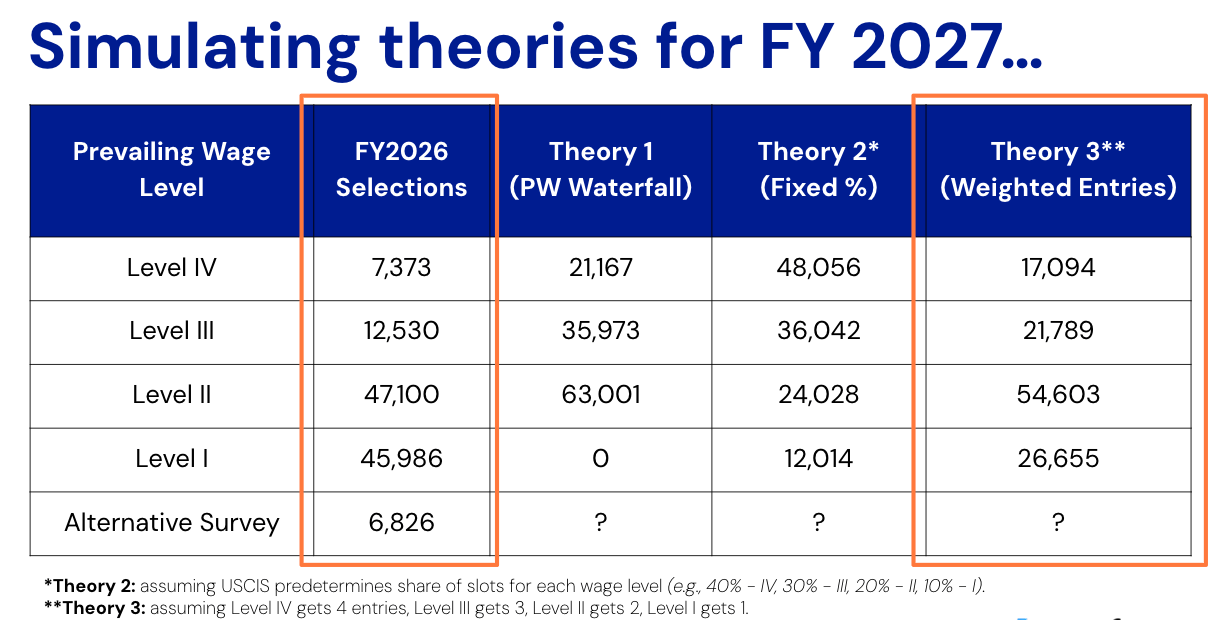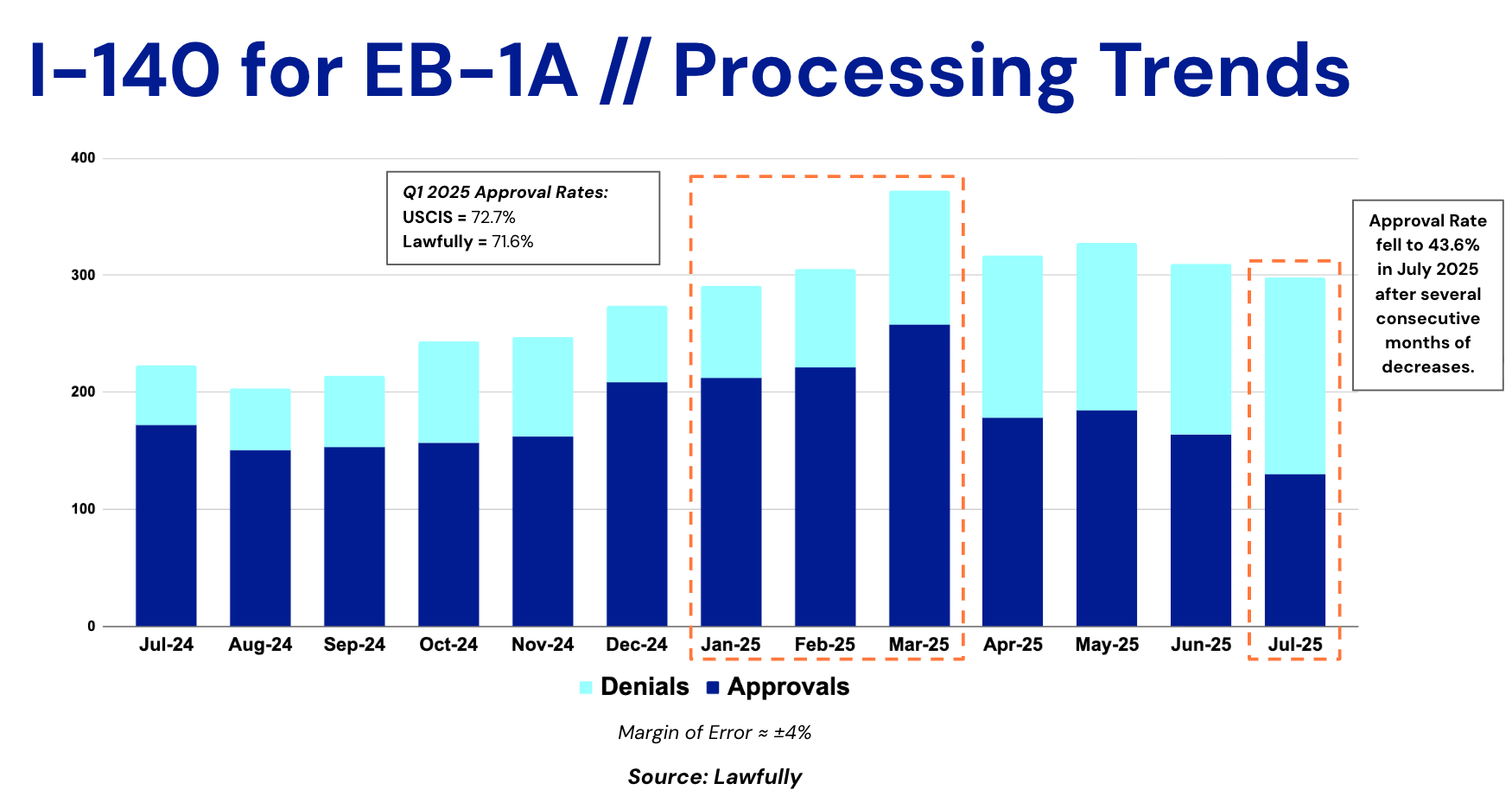- The Immigration Intel Report
- Posts
- Immigration Intel — August 27, 2025
Immigration Intel — August 27, 2025
Winners & losers of a 'Weighted Selection' H-1B lottery, EB-1A denials spike, budget impact of 200K new OPT extensions each year, and more.
☀️ Good afternoon! Today's newsletter is 1,284 words, a 6-min. read. Thanks to Doug Rand and Cecilia Esterline for contributing during their respective appearances on Lawfully’s Immigration Insiders meeting in August.
⛱️ Dog days of summer: We’re in them! So I hope all of you immigration lawyers who read this make it to some sort of beach at least one more time before Labor Day is over. It’s going to be a long autumn.
1 big thing: ‘Weighted Selection’ rule for H-1B cap pushes on—would disproportionately hurt high-volume filers.
On August 8th, the White House cleared the ‘Weighted Selection’ rule for the H-1B lottery. As of today, the details of the rule have not been released.
The theories: After conversations with several experts, I compiled the three most likely theories of how this rule will work.

We discussed these on the latest Immigration Insiders meetings with Cecilia Esterline of the Niskanen Center on August 13th, and Doug Rand—former Senior Advisor to the USCIS Director—on August 20th.
You can listen to the playback of the meeting with Doug here. Cecilia’s meeting will follow soon, so subscribe to the podcast on Spotify.
Insider’s Take: Doug noted he thinks Theory #3 is the most likely candidate for the rule. I agree, but have also heard a strong case that Theory #2 is the leader.
Lawfully Exclusive: I analyzed the 119,815 LCAs filed for H-1B cap petitions between April - June, 2025 in the latest Department of Labor data.
While imperfect, these LCA filings align closely with the 120,141 registrations selected in this year’s H-1B cap lottery—allowing us to accurately estimate the prevailing wage (PW) level breakdown of H-1B cap selections and registrations this year.

The overall impact: I gamed out the impact of each version of the rule in the table below using the LCA data from this year’s H-1B cap.
No matter which version is implemented, applicants at PW level I face lower odds and fewer overall selections next year—while PW levels III & IV will see higher odds and more overall selections than this year.
In Theories #1 and #2, selections at PW level II also take a big hit.
But in Theory #3—selections at PW level II would actually tick up a bit in next year’s lottery. That’s because there were ~135,000 registration this year for PW level II applicants, compared to ~36,000 for PW level III and ~21,000 for PW level IV.

The known-unknowns: If any version of the rule takes effect, employers will almost certainly shift strategy.
Expect more registrations for applicants at PW level III & IV. Companies may increase offered salaries, shift worksites to qualify for a higher PW level, or employ other tactics to stack the odds in their favor.
My bottom line: I crunched the numbers at the law firm and company level with the % breakdown of FY 2026 H-1B cap selections by PW level. I won’t name any names, but the high-volume filers will take the biggest hit if any version of this rule is implemented next year.
Yes—small companies and start ups that only submit a few registrations for entry level employees at lower prevailing wage levels will also be impacted. But some of the biggest H-1B filers submitted registration pools this year with 90% or more of their applicants at PW levels I & II.
It’s not to early for immigration practitioners to prepare. You may already know the PW level breakdown for your program or your client’s H-1B cap registrants historically.
But if you don’t, I do—and I’m happy to share my list on a call. Drop me a note at [email protected].
Last thing — what about legal challenges? Yes, they will mount. But for now, the Trump administration is full-steam ahead with trying to implement this change for next year’s H-1B lottery.
2. I-140 approval rate for EB-1A drops to 43% in July—according to Lawfully’s data.

The I-140 approval rate began dropping for EB-1A applications starting in April, after holding steady above 70% for a year.
Doug Rand noted in our meeting that he sees two possible reasons for the rapid drop in approval rates:
The nature of the petitioners is changing and the same standards are being applied—therefore more of these petitioners are being denied under the same standard that's been in place for a long time, or…
The standard is changing—but that should be publicly transparent through the policy manual, which has not yet happened.
To the skeptics: It’s fair to question Lawfully’s data, but EB-1A I-140s are one of our strongest samples—we directly track ~25% of all completions with USCIS each month from users in our Consumer app.*
For Apr - Jun 2025, we tracked an average of approval rate of 55%. USCIS will release its official quarterly data Sept. 30, 2025 for the same time period. July’s data not due until Dec. 30.
3. Details released for USCIS plan to end ‘Duration of Status’ for F & J visa holders—huge cost increase potentially coming for global mobility teams.
Andrew Kreighbaum of Bloomberg Law was first to report today on the 160 page text of the proposed rule, which would limit the maximum stay of F and J visa holders to 4 years.
The scope of this rule is massive: I’ll be researching and covering it in more detail in future newsletters.
For now, I'm only focusing on the potential impact for corporate global mobility teams and their employees working on F-1 OPT and STEM OPT employment authorization.
What matters for global mobility professionals: costs will go up significantly under this rule—plain and simple.
USCIS expects to receive 205,000 new F-1 Extension of Status (EOS) applications each year—with the majority tied to students transitioning into OPT status to work.
USCIS filing fees for OPT would be $470 (I-539 EOS) + $520 (I-765 EAD), or $990 total per application.
These fees would largely be paid by corporate employers on behalf of their OPT and STEM OPT employees.
This estimate does not account for additional costs that global mobility teams will incur—including variable legal fees, optional $1,685 premium processing for I-765, and USCIS/legal fees for potential dependents of F-1 visa holders.
For a global mobility program with 50-100 employees on OPT, legal and filing fee costs could increase by $50-500k per year.
More content like this…
🗓️ Register for our upcoming Immigration Insiders Meetings!
Immigration Insiders is two-way meeting for immigration practitioners featuring expert co-hosts with insider insight into the government:
Wednesday, September 3rd at 2:00pm EST — Travis Feuerbacher, former U.S. Consular Officer
Wednesday, September 17th at 2:00pm EST — Doug Rand, former Senior Advisor to the USCIS Director
Wednesday, October 1st at 2:00pm EST — Michael Valverde, former Associate Director of Operations at USCIS
🎧 Subscribe to the Realtime Immigration Podcast on Spotify!
Latest episodes:
🥳 Thanks for reading the first edition of this newsletter! I want to hear your feedback and questions, so drop me a note anytime at [email protected].
See you next week!
📝 Authors Notes:
On Lawfully’s Data: Unless otherwise noted, the data shared in this newsletter is sourced from Lawfully’s exclusive database of cases processing with USCIS, which is powered by the roughly 6 million cases that have been tracked through our consumer app for over 2.5 million foreign nationals.
If you’re interested in learning more about our methodology for sourcing and reporting on this case processing data, please email me—we are an open book.